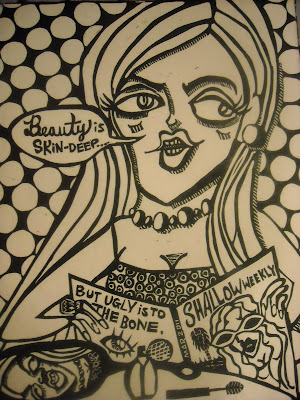
Good evening readers:
A quick update about my current project - an independent study in papermaking & printmaking.
Over the past few months I have been working on a suite of prints styled after one I made last semester.

These prints were created from the ground up. The paper used to print was hand made by me and each color plate is what is known as a "pulp painting", which is a process that involves adding colored pulp to a freshly pulled sheet of cotton paper. You can see here at the end of the entry what a pulp painting looks like without a print on it!
As a reminder, linoleum blocks are a form of relief printing where the high parts are wh
 at create the marks of the print. Think of a linoleum block as a giant, custom-made rubber stamp.
at create the marks of the print. Think of a linoleum block as a giant, custom-made rubber stamp.The image featured here aims to satirize so-called glamor and remind us that just because someone might be good looking or pretty on the outside, it doesn't mean by the same token they are a good person.
Thanks for checking it out, all my best.
-Mike
Prints are 16x20 inches on handmade paper
Color plates in a variable edition of 3
Black & Whites in an edition of 5


3 comments:
Wow. How long does something like this take to complete? It must be so exciting to realize the finished piece after such a detailed process!
The entire process takes a long while to complete - it takes patience. Time also depends on the nature of your work and style.
Step by step, here is how I do it:
You must compose a drawing in the size you are working, in this case the largest paper I can pull is 16x20", so I make a drawing on newsprint. I'd say it takes about 5 to 10 hours to complete a truly satisfactory drawing for something that is going to be transformed into a print.
Then you must trace the drawing to a piece of mylar in order to transfer it onto the linoleum block which generally takes 2 or 3 hours all things said and done. Again, this amount of time varies on the detail of your work. A 16x20 drawing is fairly large so it is easy to spend a lot of time drawing it and thus transferring it a total of two times in order to get it on the plate.
Then you must carve the block - it is a time consuming patience-demanding sort of activity that usually takes about 10 hours, once again depending on how detailed your drawing is.
Once the block is ready to print, you must take a test print to ensure it's printing exactly how you want it, but since pulp painting is part of this venture, the proof serves as a basis for making a stencil. Taking the proof requires getting your roller set up which might take about an hour.
The gestures of the pulp painting are controlled with the use of a mylar stencil which you make based off of the proof. It takes about 2 hours to make a stencil.
Now we're ready to make paper especially for the lino to be printed on, which all things and done takes about 6 hours, plus a day for the fresh paper to dry flatly in the drying system.
Give it another hour to ink up your lino block and print on your pulp paintings, it takes about an hour to do three as I have here, plus 5 B&Ws on hand made paper. It's a colossal process but I think worth it!
thanks for the feedback! and yes, it is very exciting to see it all come together!
-Mike
That is totally amazing! Thanks, Mike!
Post a Comment